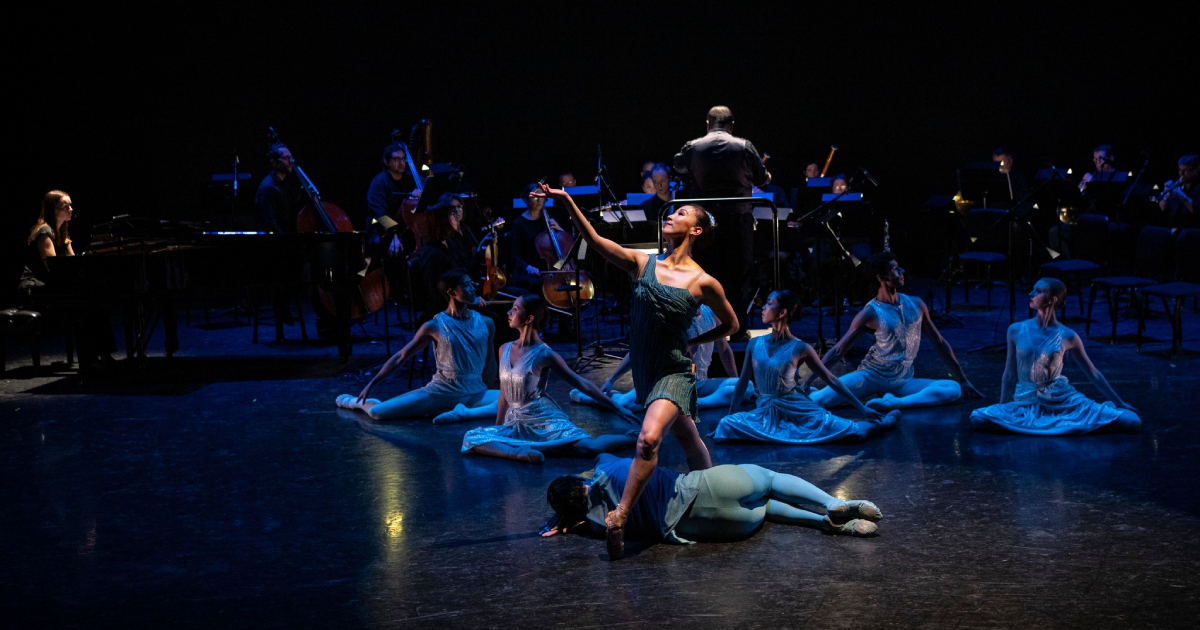To say the relationship between dance and music is an intimate one is to state the obvious, but to fully experience how nuanced movement becomes when performed to live music—how mutually responsive the musicians and the dancers become to each other’s performance and how inextricable the music is from the dance—is quite a privilege.
This extraordinary relationship and the almost magical, subtle responsiveness in the collaboration between live musicians and dancers is at the heart of the aptly named Grand Rapids Ballet season opener “Symphony of Movement.”
With a world premiere, live premieres, and the presentation of a famous classic for the first time, this extraordinary company of dancers literally shares the stage with the Grand Rapids Symphony; the musicians, rather than hiding in a pit are led by the conductor while seated upstage, and that dancers inhabit and move through the music downstage. The audience’s eyes are on both sets of performers which eliminates the separation between the music and the dance, and highlights the collaborative aspect of what these artists do. Ultimately this elevates all the players—choreographer, composer, dancer, musician, conductor, director—to the same field.
And while there are compromises necessitated by the arrangement on stage, they lead to interesting outcomes. For example, lighting designer Kenneth Keith couldn’t rely on color or patterns projected onto the cyclorama since the dancers are all downstage; and the size of the casts and their movement across the stage was limited to half the stage. But what he does with booms and patterns downstage and overhead spots is perfect.
Creative constraints often bear bold and beautiful fruit. And here, the tradeoff—to both watch and hear extraordinary musicians bring to life stunning pieces in collaboration with dancers who quite literally move through that music with a spirit incomparable to how bodies move to recorded music—is well worth it. The performance, the music and the dance, come alive spectacularly and utterly uniquely.
This is perhaps most evident in the world premiere “While Away” created on and for these dancers by Jennifer Archibald. In this thrilling work set to Edvard Grieg’s Holberg Suite (from Holberg’s Time), op. 40, ten dancers emerge in pairs, alone, and at times in trios, from the wings—the women dressed in jewel-toned bodices with matching sheer overlay to create ball gowns that reveal their legs, and the men dressed in suits with sheer arms. Very much rooted in classical ballet and performed exquisitely en pointe, the piece is shot through with big, dramatic lifts—the men twirl and carry the women in attitude on their shoulders, at times flipped upside down. There is terrific style and undulating attitude to this grand ballroom and play with tempo and lines—a quickness and brightness, a joyful responsiveness to the music.
The ways in which Archibald worked directly with the dancers in a collaborative creative process to make this dance shines through in the way the dancers seem to enjoy and fully embody the push-pull energy, the beautiful stage pictures, the heightened musicality of this delightful piece.
Other new works performed live for the first time are two pandemic-era collaborations between Grand Rapids Ballet Artistic Director James Sofranko and Grand Rapids Symphony Conductor Marcelo Lehninger originally created as pas de deux to enhance the symphony’s virtual programming.
“Evensong”, set to 19th Century Brazilian composer Antonio Carlos Gomes’s “Ave Maria”, remains a lovely, ethereal soft shoe pas de deux between Talia Young and Nathan Young dressed in white. Softly and gently, they flow through the music like a prayer.
“Aubade” has evolved from a pas de deux between Greco-Roman goddess of the hunt Diana and a mortal man into a unique, mini storybook ballet complete with a chorus of six who heighten the drama. Set to Francis Poulenc’s “choreographic piano concerto” (with wonderful soloist Liz Ames) and inspired by George Balanchine, who once choreographed to this score but the steps have been lost, the dance embodies Mr. B’s neoclassical style, including quick, athletic movements, syncopated timing, open arabesques, and a focus on the movement’s aesthetic more than plot.
Yuka Oba-Muschiana is a fierce Diana with wonderful sass who is matched beautifully with Josué Justiz (the two played Romeo and Juliet among other principal roles together in recent years) who lifts and turns her delicately and a completion that comes in miraculous weight-sharing, balancing, and gliding together.
And perhaps the most tender of all the night’s dances is Lar Lubovitch’s “Duet from Concerto 622.” Considered “the most famous male duet in the international dance world” by The New York Times, this selection from a larger work created in 1985 honors the terrific love and loss of the AIDS crisis. Two men (Sam Epstein and Julian Gan on opening night) dressed in khaki chinos and white polo shirts create connected shapes with their bodies—looping hearts with outstretched arms and fingers touching, arms across shoulders walking lightly downstage—and, at turns, support each other with beautiful lines and offer dynamic solos. Set to Mozart’s titular clarinet concerto (exquisitely performed by Georgiy Borisov), this lovely piece provoked a standing ovation.
“Symphony of Movement” offers the profound realization of true collaboration—of form, of artists, of community organizations. If this opening program is indicative of what’s to come in Grand Rapids Ballet’s new season, we’re in store for quiet innovation as well as reverence to the greats amid a grand spirit of generosity as well as true excellence in collaboration.
Symphony of Movement
Grand Rapids Ballet
Oct. 11-13
https://grballet.com/symphony-of-movement/





